Kratky Basil
Grow Basil Hydroponically
Using Kratky Hydroponics, growing basil is really easy and fun. The Kratky Method of Hydroponics makes it simple to grow basil indoors all year long.
Kratky Basil Containers
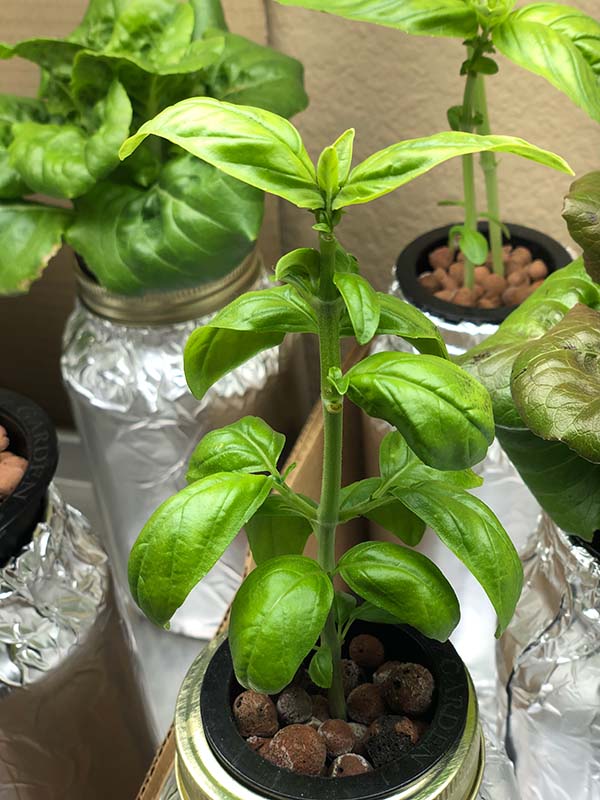
Kratky Basil
Grown in mason jars without soil using hydroponic Kratky method.
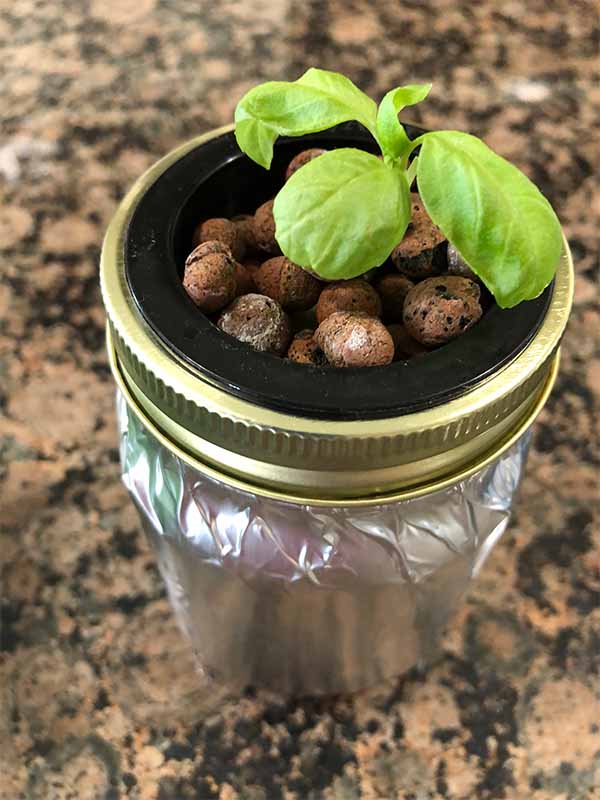
Basil Grown with Kratky
Growing basil in mason jars (Kratky method basil) is simple and fun.
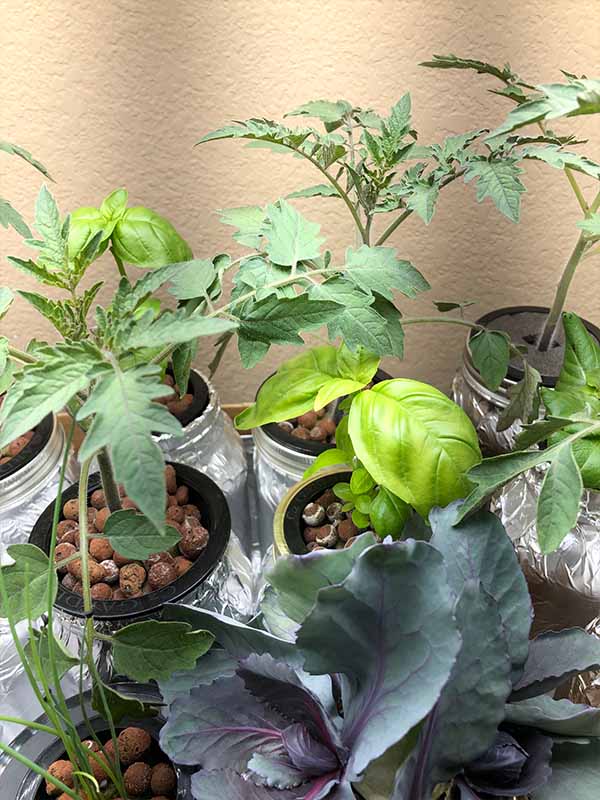
Kratky Basil Grows Well
Nestled in with other plants, Basil Kratky style grows well under grow lights.
How to Grow Basil with the Kratky Method
One of the first plants I grew using the Kratly Method was Kratky basil. It is one of the easiest and most proficient plants you can grow. Basil is very hearty and can be cloned to keep plants growing year-round, without the need to replant seeds. I have grown many varieties of basil over the years, using the simple Kratky method.
What do you need to grow basil hydroponically Kratky-style?
- Kratky container for growing your basil, such as a mason jar
- Net cups to place the growing medium and plants in
- Growing medium, like rockwool to grow healthy basil plants
- Clay pebbles to block light and wick moisture to the roots
- Nutrient solution and water
It really is that simple!
Amazon Favorites We Use for Our Kratky Basil
Advertisement
As an Amazon Associate I earn from qualifying purchases.
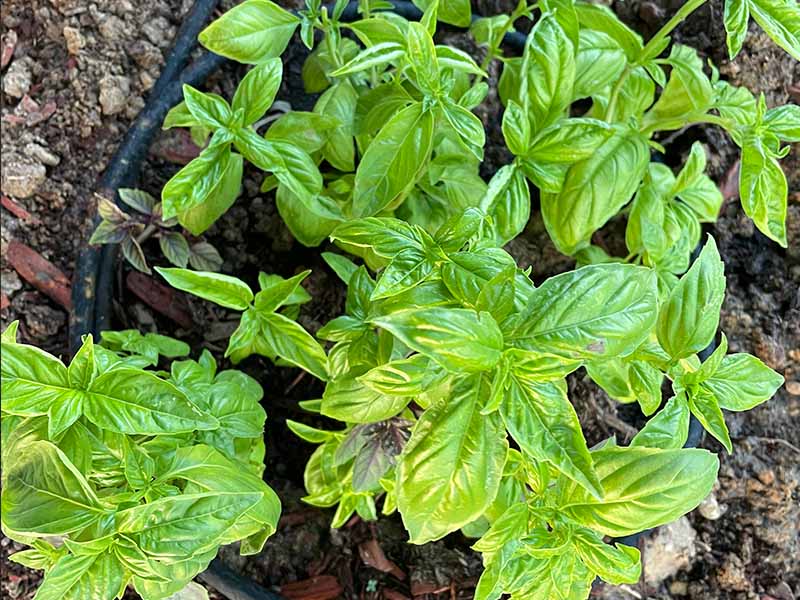
Health basil plants growing outdoors after being transplanted from hydroponic Kratky method basil to outdoor soil garden.
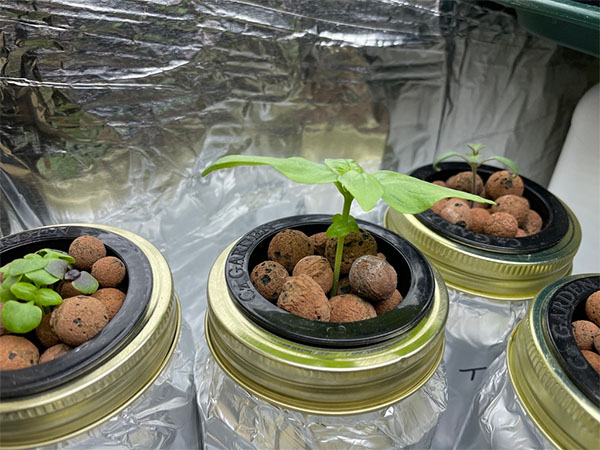
Basil seedlings popping up from being started in rockwool and net cups. The basil comes up fast after sprouting.
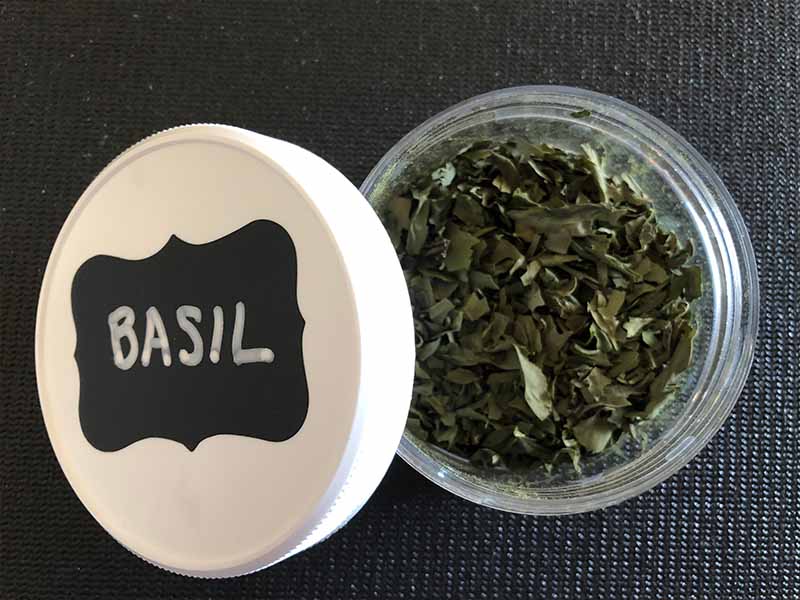
Dried basil from my Kratky garden. I harvest the basil and then dry it on low in the oven until ready to store for when I need dried basil.
Basil Varieties that Thrive in Hydroponic Gardens
Here are several varieties of basil that thrive in hydroponic systems, each offering unique flavors and characteristics. Here are some of the best types:
Sweet Basil (Ocimum basilicum)
Sweet basil is the most common type of basil used in cooking due to its classic flavor profile, which combines peppery notes with hints of clove and anise. It is versatile and pairs well with a wide range of dishes, including pasta, salads, and sauces. Sweet basil is easy to grow hydroponically and typically produces abundant foliage, making it a favorite among hydroponic gardeners.
Genovese Basil (Ocimum basilicum ‘Genovese’)
Genovese basil is a cultivar of sweet basil known for its large, tender leaves and intense aroma. It is particularly prized in Italian cuisine, where it is used to make traditional pesto sauce. Genovese basil has a robust flavor with undertones of lemon and mint, making it a popular choice for hydroponic cultivation. Its vigorous growth habit and high essential oil content make it well-suited for hydroponic systems.
Thai Basil (Ocimum basilicum var. thyrsiflora)
Thai basil is a variety of basil native to Southeast Asia, valued for its distinctive flavor and aroma. It has a slightly spicy taste with hints of licorice and mint, which add depth to Asian dishes such as stir-fries, curries, and noodle soups. Thai basil also has ornamental purple stems and flowers, making it an attractive addition to hydroponic gardens. It thrives in warm, humid conditions, making it well-suited for hydroponic cultivation.
Lemon Basil (Ocimum basilicum ‘Citriodorum’)
Lemon basil, as the name suggests, has a pronounced lemon scent and flavor that sets it apart from other basil varieties. Its bright citrus notes make it a refreshing addition to salads, seafood dishes, and desserts. Lemon basil is easy to grow hydroponically and benefits from regular pruning to encourage bushy growth and prolong harvests. Its aromatic foliage adds a burst of freshness to any hydroponic garden.
Holy Basil (Ocimum tenuiflorum)
Also known as tulsi, holy basil is revered for its medicinal properties and spiritual significance in Hindu culture. It has a spicy, clove-like flavor with hints of peppermint and licorice, making it a unique addition to herbal teas, infused oils, and medicinal preparations. Holy basil requires warm temperatures and ample sunlight to thrive, making it well-suited for hydroponic cultivation in controlled environments.
The Right Basil is the Most Flavorful
Overall, these basil varieties offer a range of flavors and aromas that cater to diverse culinary preferences, making them excellent choices for hydroponic cultivation.
Basil Varieties
- Sweet Basil (Ocimum basilicum)
- Genovese Basil (Ocimum basilicum ‘Genovese’)
- Thai Basil (Ocimum basilicum var. thyrsiflora)
- Lemon Basil (Ocimum basilicum ‘Citriodorum’)
- Holy Basil (Ocimum tenuiflorum)
- Purple Basil (Ocimum basilicum ‘Purpurascens’)
- Cinnamon Basil (Ocimum basilicum ‘Cinnamon’)
- African Blue Basil (Ocimum kilimandscharicum × basilicum ‘Dark Opal’)
- Spicy Globe Basil (Ocimum basilicum ‘Spicy Globe’)
- Lettuce Leaf Basil (Ocimum basilicum ‘Lettuce Leaf’)
- Greek Basil (Ocimum basilicum ‘Greek’)
- Italian Large Leaf Basil (Ocimum basilicum ‘Italian Large Leaf’)
- Bush Basil (Ocimum basilicum ‘Bush’)
- Licorice Basil (Ocimum basilicum ‘Licorice’)
- Lime Basil (Ocimum americanum)
- Cardinal Basil (Ocimum basilicum ‘Cardinal’)
- Fino Verde Basil (Ocimum basilicum ‘Fino Verde’)
- Red Rubin Basil (Ocimum basilicum ‘Red Rubin’)
- Dark Opal Basil (Ocimum basilicum ‘Dark Opal’)
- Mammoth Basil (Ocimum basilicum ‘Mammoth’)
- Siam Queen Basil (Ocimum basilicum ‘Siam Queen’)
- Purple Ruffles Basil (Ocimum basilicum ‘Purple Ruffles’)
- Christmas Basil (Ocimum basilicum ‘Christmas’)
- Nufar Basil (Ocimum basilicum ‘Nufar’)
- Ararat Basil (Ocimum basilicum ‘Ararat’)
- Emily Basil (Ocimum basilicum ‘Emily’)
- Dolce Fresca Basil (Ocimum basilicum ‘Dolce Fresca’)
- Magical Michael Basil (Ocimum basilicum ‘Magical Michael’)
- Large Leaf Italian Pesto Basil (Ocimum basilicum ‘Large Leaf Italian Pesto’)
- Lime Lemon Basil (Ocimum americanum ‘Lime Lemon’)
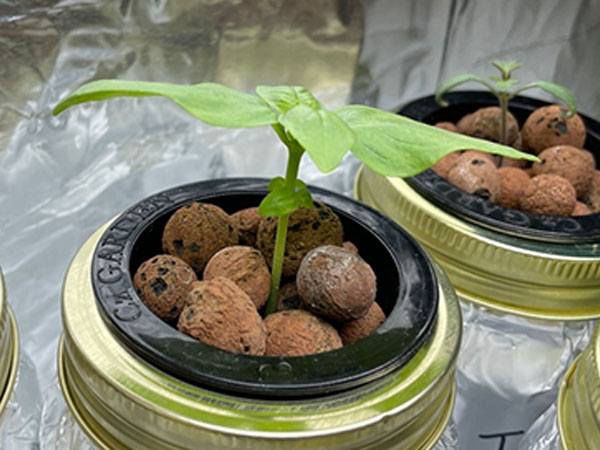
Advertisement
I bought these CZ net cups and will never buy another brand. They have been used year over year 5+ years.
I love these gro-block rockwool cubes. They keep the rockwool off your hands and soak well.
Before I got these, I used clay pebbles and/or foam cutouts. These fit so much better and block all light.
This is only wishlist. I plan on trying these in the the fall. You can see in my pics I currently use tin foil.
As an Amazon Associate I earn from qualifying purchases.
Basil for Medicinal Purposes?
Basil, beyond its culinary uses, does have some potential medicinal properties, primarily attributed to its essential oils and other compounds. While more research is needed to fully understand its medicinal benefits, basil has been traditionally used in various cultures for its purported healing properties. Here are some potential medicinal purposes of basil used by other cultures (this is not medical advice, so please do your own research):
Anti-inflammatory Properties: Basil contains compounds like eugenol, which have been studied for their anti-inflammatory effects. These properties may help reduce inflammation in the body, potentially benefiting conditions such as arthritis and inflammatory bowel diseases.
Antioxidant Activity: The essential oils found in basil, particularly those from varieties like holy basil (Ocimum tenuiflorum), exhibit antioxidant properties. Antioxidants help neutralize harmful free radicals in the body, thereby protecting cells from oxidative damage and reducing the risk of chronic diseases like heart disease and cancer.
Antimicrobial Effects: Basil essential oil contains compounds with antimicrobial properties, which may help inhibit the growth of bacteria, viruses, and fungi. This antimicrobial activity could potentially aid in fighting infections and promoting overall immune health.
Stress Reduction and Adaptogenic Effects: Holy basil, also known as tulsi, is revered in Ayurvedic medicine for its adaptogenic properties, meaning it may help the body adapt to stress and promote balance. Consuming holy basil tea or supplements is believed to have calming effects on the mind and body, potentially reducing stress and anxiety.
Respiratory Support: Basil is often used in traditional medicine to alleviate respiratory symptoms such as coughs, colds, and asthma. Its expectorant properties may help loosen mucus and relieve congestion, while its antimicrobial effects could help fight respiratory infections.
Digestive Aid: Basil has been used historically to aid digestion and relieve digestive discomfort. Compounds like eugenol and linalool found in basil may help stimulate digestive enzymes and soothe digestive upset.
Cardiovascular Health: Some studies suggest that basil may have beneficial effects on cardiovascular health. Compounds like eugenol and rosmarinic acid may help lower blood pressure, reduce cholesterol levels, and improve blood vessel function, though more research is needed to confirm these effects.
It’s important to note that while basil shows promise for various medicinal purposes, more scientific research is needed to validate its efficacy and safety for specific health conditions. Basil supplements or extracts should be used under the guidance of a healthcare professional, especially if you have any underlying health conditions or are taking medications.










